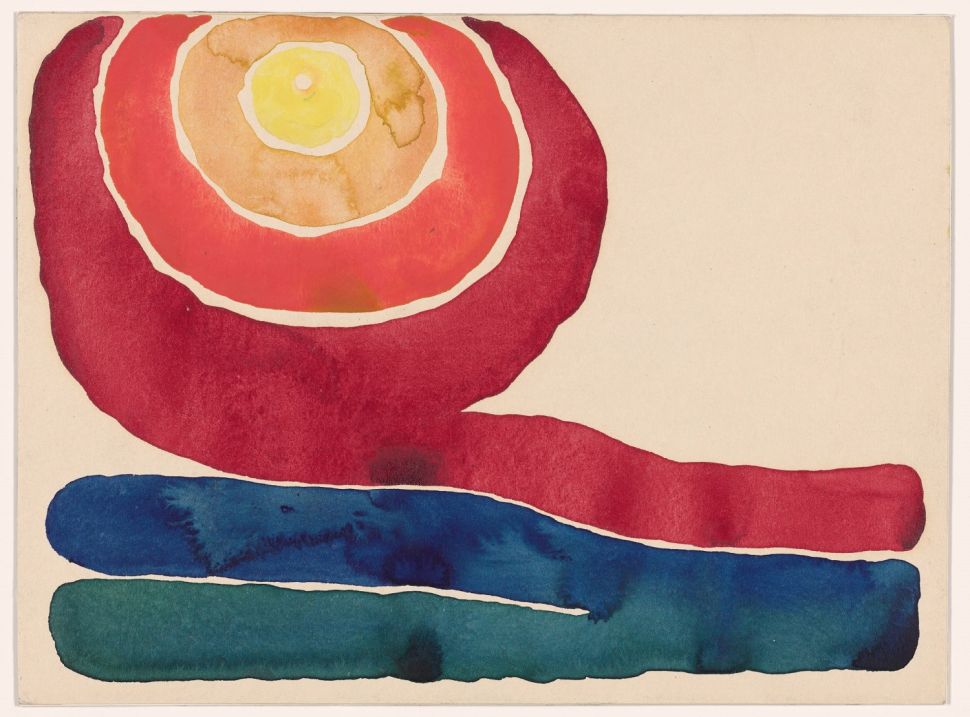
Georgia O’Keeffe was extremely particular in her material choices, says Samantha Friedman, Associate Curator in the Museum of Modern Art’s Department of Drawings and Prints, and particular about how she used them. While the influential 20th Century artist may be best remembered for her paintings of curvacious florals, rugged deserts and sun-bleached bones, her lifetime body of work encompasses so much more—including hundreds of paintings and drawings on paper, often produced in series, that showcase her dedication to realizing her aesthetic vision.
Subscribe to Observer’s Arts Newsletter
More than 120 of those works are on view at the Museum of Modern Art in Georgia O’Keeffe: To See Takes Time, including organic landscapes, the abstract charcoal sketches she called “specials,” portraits, aerial views and her signature flowers. Seldom seen together, these drawings and paintings sourced from 58 different lenders immerse visitors in the artist’s quest for perfection. The aptly named exhibition highlights O’Keeffe’s artistic process, which often involved consecutive and transformative interpretations of the same subject.
In her aesthetic explorations, O’Keeffe altered shape and hue, sometimes sketching or drawing the same subject in rapid succession. Her motivations for working in series include not only dissatisfaction (“Thought I knew what I was going to try to do but I find I dont—and I guess I’ll only find out by slaving away at it,” she wrote to classmate Anita Pollitzer) but also enjoyment (“I’ve been working like mad all day—had a great time.”)
Casual O’Keeffe fans familiar only with her iconic paintings may be surprised by what they see in To See Takes Time because the artist’s works on paper aren’t always recognizably hers. Friedman says that when she included a 1959 charcoal from the museum’s collection in a 2020 exhibition, “visitors were shocked to learn that this was a work by Georgia O’Keeffe; it so didn’t conform to our associations with the artist.”

The exhibition showcases O’Keeffe’s obsession with perfecting her vision and calming her thoughts through labor. Some of the featured series groupings suggest she was unaware of where her creative impulses would lead. Paper, which she could use and discard, offered a freedom that canvas did not, and the flow of her output was governed by her ideas in the moment. “Why—it’s just like scrap paper,” O’Keeffe told Alfred Stieglitz, “I throw it in the scrap heap and go on to something else.”
The exhibition marks the first reunion of all eight watercolors in O’Keeffe’s Evening Star series, which depicts Venus shining in a color-drenched sky as seen from the rustic Canyon, Texas landscape. “That evening star fascinated me,” O’Keefe recounted in her autobiography. “I had nothing but to walk into nowhere and the wide sunset space with the star.” She painted that star in watercolor again and again, in both hazy pastels with cloud-like formlessness and bright, saturated hues with hard edges.
To See Takes Time is MoMA’s first Georgia O’Keeffe retrospective since 1946, the year of the earliest O’Keeffe retrospective and the museum’s first ever devoted to a female artist. That exhibition, which O’Keeffe herself had a hand in preparing, displayed her seminal botanical motif paintings, landscapes and abstract works and emphasized the full flower of her creative energy. To See Takes Time is an appropriate—if too long in coming—follow-up. In it, we are privileged to see exactly how that flower took root and how much effort it required to bloom.
Georgia O’Keeffe: To See Takes Time is on view at the Museum of Modern Art through August 12.

